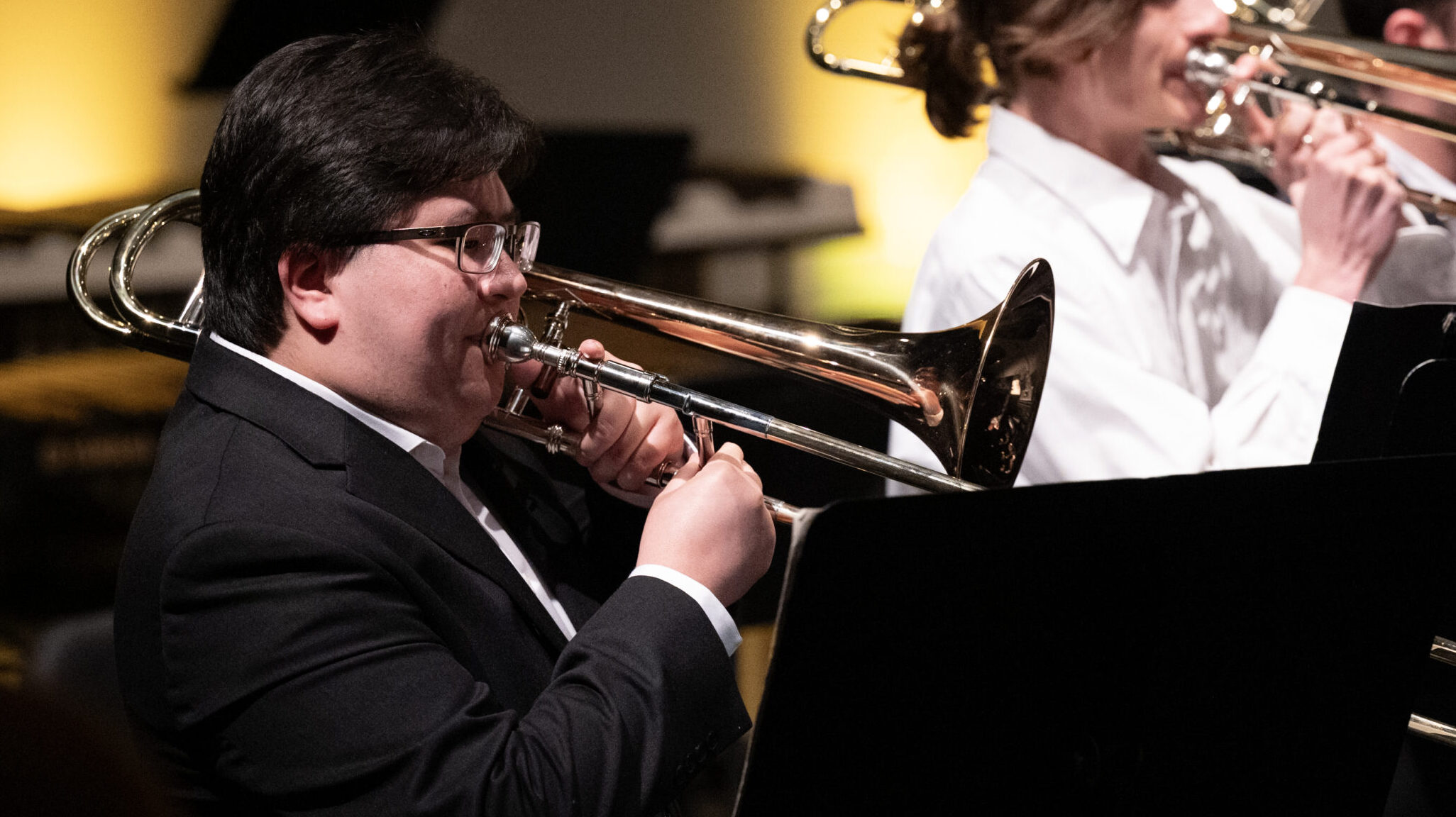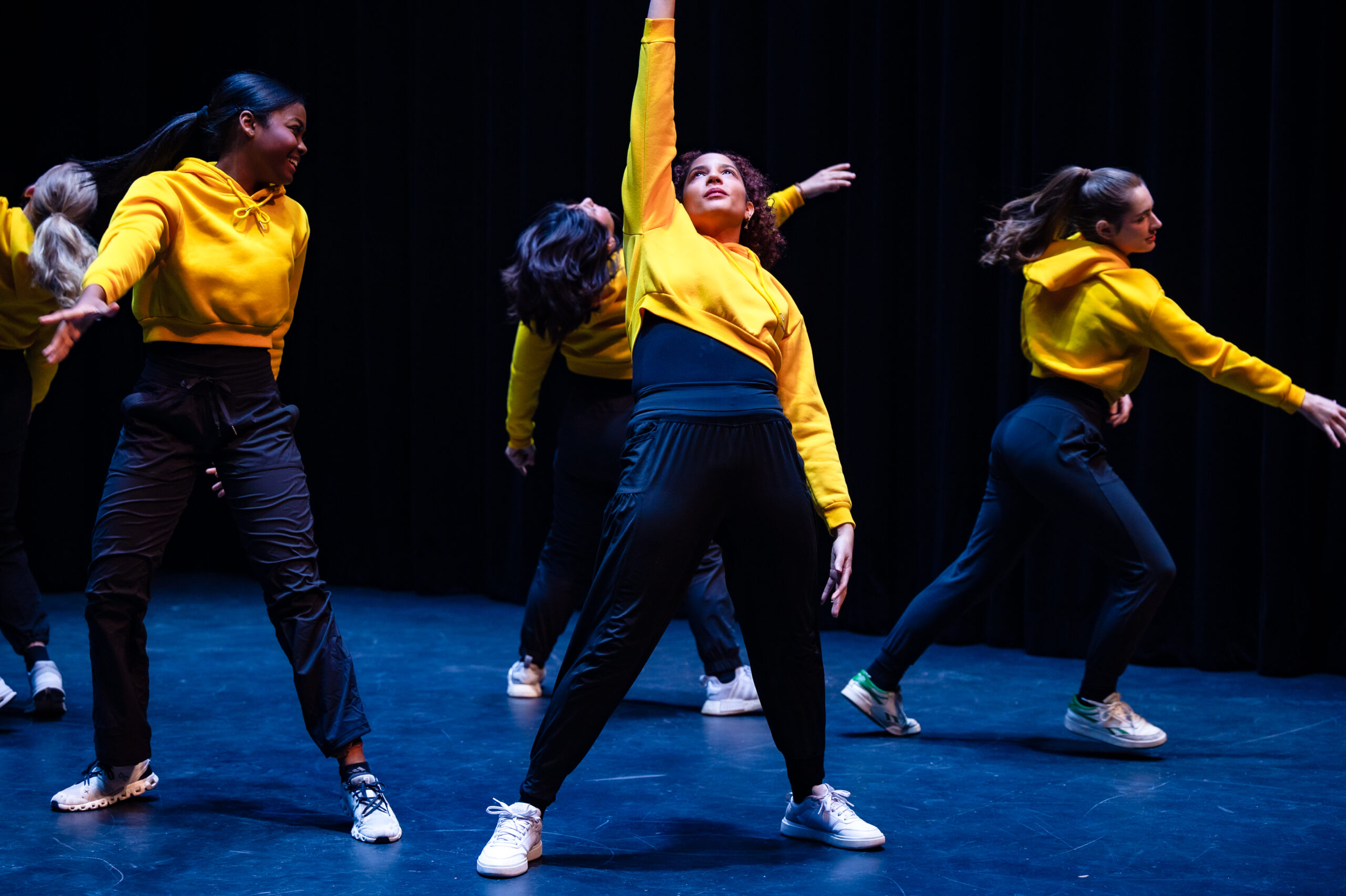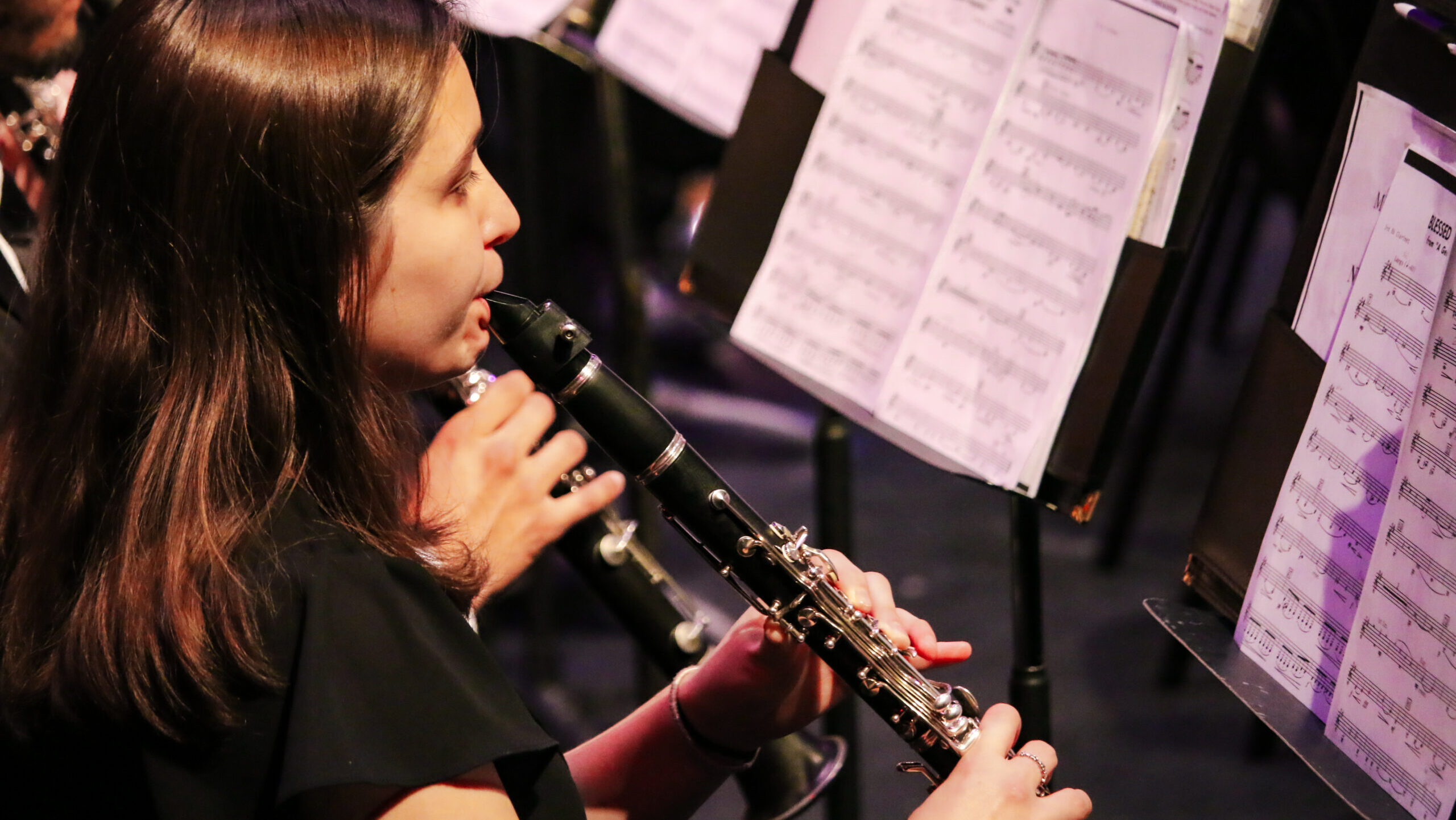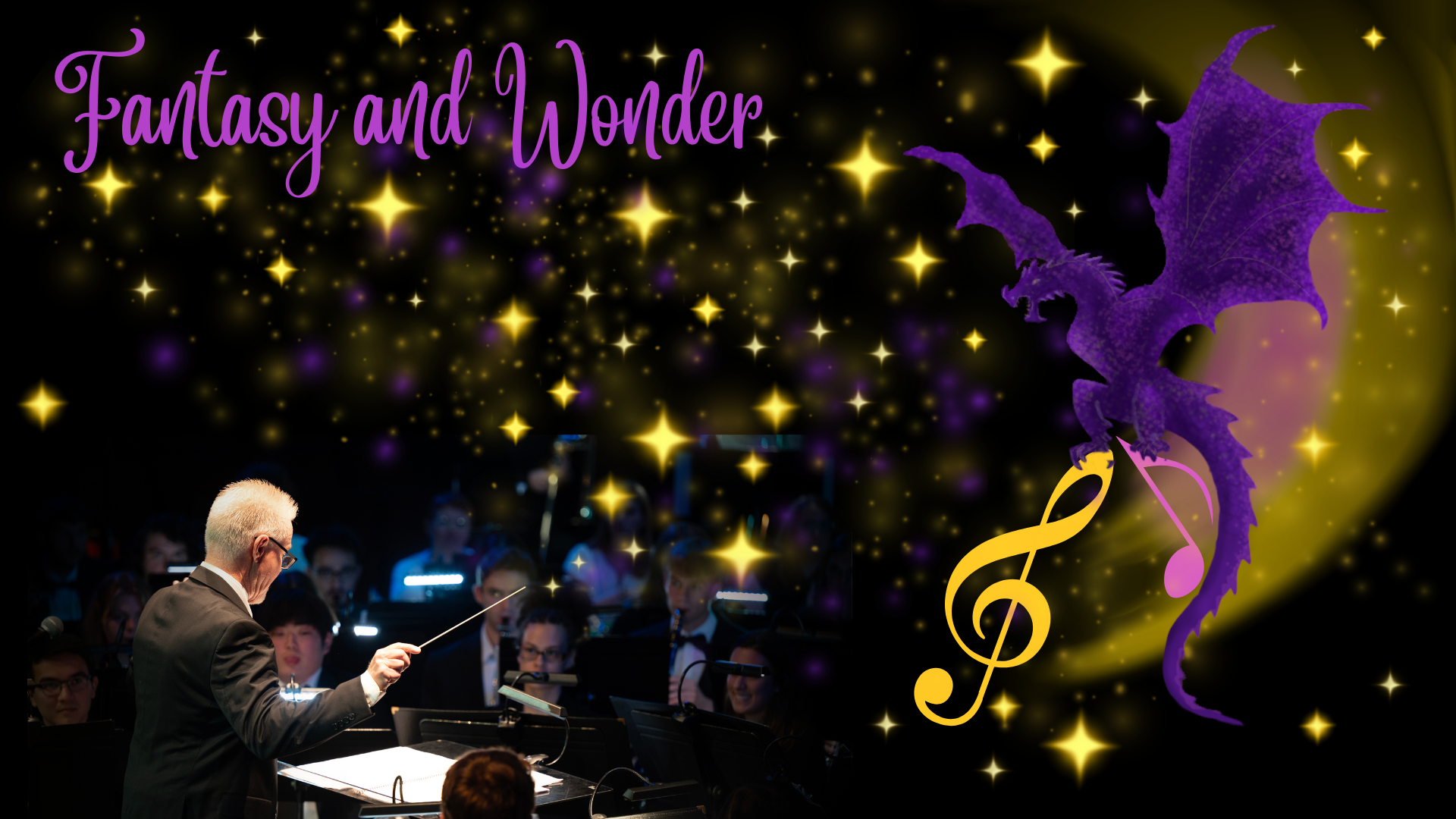NC State Department of
Performing Arts and Technology
presents
NC State Wind Ensemble
Featuring
Trombone Choir
Woodwind Quintet
Tuba-Euphonium Ensemble
Paul Garcia, conductor
Performance Overview
Jump to a specific spot in the program.
PROGRAM
Select a title for more information.
Creep
Thom Yorke
Arranged by Cornelius Boots
Performed by the Bass Clarinet section.
Bass Clarinet section
- Jake Bramhall
- Drew Guettler
- E. Chapman
- Laura Dale
Appalachian Fantasy
Chris Sharpe
Performed by the Trombone Choir under the direction of Dr. J. Mark Whitfield.
Trombone Choir
- Max Abelson
- Jack Fitzpatrick
- Harrison Fringer
- Lucy Grindstaff
- Carter Harrington
- Jonathan Jenkins
- Chris MacKay
- Zach Moore
- Jayan Patel
- Ben Poovey
- Zack Powers
- Paige Ray
- Luke Sbityakov
- Ben Sheldon
- Luke Tilly
- Liam Weiss
Quintet Op: 56 No. 2: I. Allegretto
Franz Danzi
Performed by the Woodwind Quintet under the direction of Mary Boone.
Woodwind Quintet
- Reese Neff
- Timothy Cho
- Bella Russ
- Margaret Lawrimore
- Will Hager
Aubade
Adrien Barthe
Performed by the Woodwind Quintet under the direction of Mary Boone.
Woodwind Quintet
- Reese Neff
- Timothy Cho
- Bella Russ
- Margaret Lawrimore
- Will Hager
Drei Equalizer
Anton Bruckner
Performed by the Tuba-Euphonium Ensemble under the direction of Dr. J. Mark Whitfield.
Tuba-Euphonium Ensemble
- Rico Abelson
- Ben Arcuri
- Daniel Bailey
- Charlie Ford
- Jonathan Jenkins
- Ben Poovey
- Brian Rossi
- Luke Ryan
- Igor Silva
- David Vigil
- Payton Wurst
“Andante” from Andante et Scherzo
Eugene Bozza
Performed by the Saxophone section.
Saxophone section
- Cameron Kellner
- Seth Olanovich
- Nathaniel Baird
- Jack Fulp
- Katherine Fowler
- Matt Cash
Origin
Cait Nishimura
About Origin
“Origin was commissioned by Dr. Jeff Reynolds for the University of Toronto Wind Ensemble. As an alumna of the school and former student of Dr. Reynolds, it was an honour to compose this short fanfare to open the 2022-23 concert season at U of T. Origin is an uplifting, empowering piece that evokes the feeling of returning home to a significant place in one’s journey, reflecting on all that has changed and all that has remained. I have come to cherish the magical full-circle experiences that occur when my music is performed in spaces that were meaningful or inspiring to me as a young musician. This piece is an ode to all the people and places that leave a lasting impact on the lives of others.”
Cait Nishimura
The World is Waiting for the Sunrise
Eugene Lockhart and Ernest Seitz
Scored by Harry L. Alford
About The World is Waiting for the Sunrise
The World is Waiting for the Sunrise is a post-World War I popular song with lyrics by American actor Eugene Lockhart, and music composed by Canadian-born pianist Ernest Seitz. The piece was written in 1918 and published on January 24, 1919. The song originally was recorded by band leader, Isham Jones and his dance orchestra in October 1922. The piece entered the national charts on November 11, 1922, and peaked at number 2 during a six-week run. It finished the year as the number 19 single for 1922. More than one hundred versions have been commercially released. Some notable performers to record a version of the original song include Benny Goodman, Duke Ellington, Django Reinhardt, Machito, and The Beatles (then known as The Quarrymen).
A. A. Harding commissioned Harry Alford to arrange the ballad into a euphonium feature halftime selection for the University of Illinois Marching Band. On the day of the scheduled premiere (November 3, 1934), heavy rain caused many of the spectators to leave the stands before halftime. As the first notes of The World is Waiting for the Sunrise sounded, the rain reportedly ceased, and the sun shone through the clouds long enough for the band to perform the work.
Angels in the Architecture
Frank Ticheli
Soprano Solo
Anna Muchukot
About Angels in the Architecture
“Angels in the Architecture was commissioned by Kingsway International, and received its premiere performance at the Sydney Opera House on July 6, 2008, by a massed band of young musicians from Australia and the United States, conducted by Matthew George. The work unfolds as a dramatic conflict between the two extremes of human existence – one divine, the other evil.
The work’s title is inspired by the Sydney Opera House itself, with its halo-shaped acoustical ornaments hanging directly above the performance stage. Angels in the Architecture begins with a single voice singing a 19th-century Shaker song:
I am an angel of Light
I have soared from above
I am cloth’d with Mother’s love.
I have come, I have come,
To protect my chosen band
And lead them to the promised land.
This “angel” – represented by the singer – frames the work, surrounding it with a protective wall of light and establishing the divine. Other representations of light – played by instruments rather than sung – include a traditional Hebrew song of peace (“Hevenu Shalom Aleichem”) and the well-known 16th-century Genevan Psalter, “Old Hundredth.” These three borrowed songs, despite their varied religious origins, are meant to transcend any one religion, representing the more universal human ideals of peace, hope, and love. An original chorale, appearing twice in the work, represents my own personal expressions of these aspirations.
In opposition, turbulent, fast-paced music appears as a symbol of darkness, death, and spiritual doubt. Twice during the musical drama, these shadows sneak in almost unnoticeably, slowly obscuring, and eventually obliterating the light altogether. The darkness prevails for long stretches of time, but the light always returns, inextinguishable, more powerful than before. The alternation of these opposing forces creates, in effect, a kind of five-part rondo form (light-darkness-light-darkness-light). Just as Charles Ives did more than a century ago, Angels in the Architecture poses the unanswered question of existence. It ends as it began: the angel reappears singing the same comforting words. But deep below, a final shadow reappears – distantly, ominously.”
-Frank Ticheli
MEET THE PERFORMERS
NC State Wind Ensemble
FLUTE
Kate Sullivan
Mollie Powell
Ellie Murray
Rebecca Moore
Caitlyn Potter
Evan Yun
Katie Phillips
CLARINET
Kyle Hinckley
Will Hager
Jordan Eilers
Jacob Timin
Claire Siegel
Matt Nguyen
Emmie Cumby
Sela Bettoli
Lizzie Rappaport
Faith Richards
Allison Martinko
Matthew Adams
Pen Hunter
Mia Olgine
OBOE
Megan Vezzetti
Timothy Cho
Bassoon
Erika Fetvedt
SAXES
Cameron Kellner (alto)
Seth Olanovich (alto)
Nathaniel Baird (alto)
Jack Fulp (tenor)
Katherine Fowler (tenor)
Matt Cash (tenor)
BASS CLARINET
Jake Bramhall
Drew Guettler
E Chapman
Laura Dale
BASS
Henry Henderson
HORN
Alex Troutman
Catherine Farnham
Trevor Petzold
Erik Svanes
Johan Catlin
TRUMPET
Joshua Fesmire (co-principle)
Doug Leavy (co-principle)
Joshua Aycock
Adah Morton
James Rhile
Kai Taylor
Margarita Gina
Gattis Smith II-McNeill
TROMBONE
Ben Poovey
Luke Sbityakov (bass)
Max Abelson
Liam Weiss (bass)
Jack Fitzpatrick
Zack Powers
Euphonium
Brian Rossi
Daniel Bailey
Andrea Galilea
TUBA
Rico Abelson
Tyler Smith
Scott Elliott
Bennett Petzold
Percussion
Jordyn Fishkin
Jason Fogelsonger
Vadin Ha
Zeiad Yakout
Jiovanni Ortiz-Anglero
Elizabeth Ingram
Emma Hamrick
PIANO
Elaine Wolochuk
Trombone Choir
Max Abelson
Jack Fitzpatrick
Harrison Fringer
Lucy Grindstaff
Carter Harrington
Jonathan Jenkins
Chris MacKay
Zach Moore
Jayan Patel
Ben Poovey
Zack Powers
Paige Ray
Luke Sbityakov
Ben Sheldon
Luke Tilly
Liam Weiss
Woodwind Quintet
Reese Neff
Timothy Cho
Bella Russ
Margaret Lawrimore
Will Hager
Tuba-Euphonium Ensemble
Rico Abelson
Ben Arcuri
Daniel Bailey
Charlie Ford
Jonathan Jenkins
Ben Poovey
Brian Rossi
Luke Ryan
Igor Silva
David Vigil
Payton Wurst
MORE FROM THE DEPARTMENT
- Categories:



